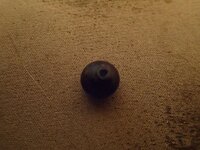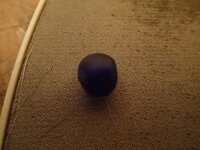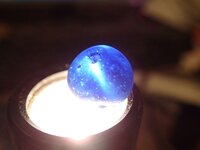BosnMate
Gold Member
- Sep 10, 2010
- 6,916
- 8,441
- Detector(s) used
- Whites MXT, Whites DFX, Whites 6000 Di Pro
- Primary Interest:
- Other
I have a little more information on trade beads. The first photo I've posted before, it's some beads I found when a young boy. At the beginning of WWII the Army put emplacements along the coast of California. We lived near Avila Beach, and in the summer time Mom would take us to the beach to swim. It just so happened that one of the Army's emplacements was in the middle of an ancient Indian mound, which is totally gone now, due to widening the road. But us kids would play army up there, and during those times I picked up a bunch of beads, which I would take to Mom, and she saved them. Among those beads I found three white glass trade beads, which I didn't put in the frame, but I still have them. First, here is a picture of the stone age beads I found.
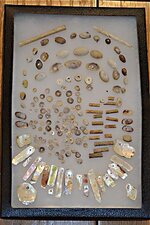
The white trade beads are called "Padre" beads, supposedly because those were traded a lot by the Spanish priests that came to California first. The mission in San Luis Obispo was established in 1772, missions further south were even before that. San Luis Obispo is 13 miles from Avila Beach, so the odds are that those white glass beads were traded by the early Spanish. Beyond that I had an uncle who in the late 20's, early 30's was on a survey crew working for the power company. They went into existing lakes in the high country of the Sierra Nevada mountains and dammed up the outlets of the lakes so that they would store considerably more water for their hydro electric dams down stream. He found the beads in the next picture in the area of one of their camps in the Northern part of the Sierra range.
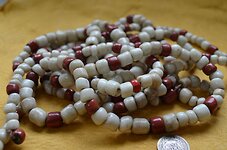
All told, he found over 300 White Padre beads, and darn near a 100 of the red beads. Some of the red beads are two layer beads, with a greenish glass on the inside, brick red outside. The others, probably more than half are solid red, and I'll go out on a limb and call them "Red Padres." I know for a fact that there are Blue Padre Beads.
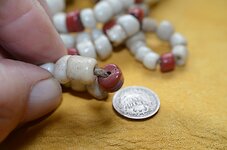
Out of all those beads he found, only one was a white heart. Which is the red bead in the center of the second picture.
Now you can see from the pictures that the Padre Beads are larger. There are also white beads that are very small. The smallest beads are called "Seed Beads," while ones slight larger are called "Pony Beads." The seed beads and pony beads all come in all sorts of colors, I just only have white ones.
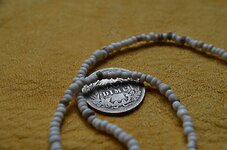
The above are seed beads, note how many it takes to cross the dime. The next picture shows "Pony Beads."
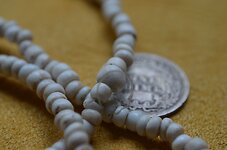
Note the larger size. Pony is the size of a wooden keg, and these beads were shipped in Pony Kegs, which is supposedly why they are called "Pony Beads."
Next is a photo of both pony and seed beads. These beads are from the Eastern Seneca Indians, and were found in the 1940's, in Livingston County New York, having been screened from a plowed field, and were sent to me as a gift.
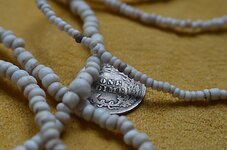
This post is getting picture heavy, so I think I'll end with two more pictures of Padre beads, and then start another and final post. Pi9ctured below are white and blue Padres.
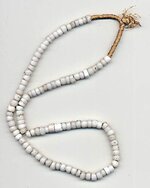
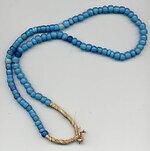
Notice the heavy grass cord that they are strung on. That's a dead giveaway that they came from Africa.
I have no idea why the computer decided to stick those last two pictures on below the padres, but on my screen they are huge enlargements, and it shows the white heart bead really well.

The white trade beads are called "Padre" beads, supposedly because those were traded a lot by the Spanish priests that came to California first. The mission in San Luis Obispo was established in 1772, missions further south were even before that. San Luis Obispo is 13 miles from Avila Beach, so the odds are that those white glass beads were traded by the early Spanish. Beyond that I had an uncle who in the late 20's, early 30's was on a survey crew working for the power company. They went into existing lakes in the high country of the Sierra Nevada mountains and dammed up the outlets of the lakes so that they would store considerably more water for their hydro electric dams down stream. He found the beads in the next picture in the area of one of their camps in the Northern part of the Sierra range.

All told, he found over 300 White Padre beads, and darn near a 100 of the red beads. Some of the red beads are two layer beads, with a greenish glass on the inside, brick red outside. The others, probably more than half are solid red, and I'll go out on a limb and call them "Red Padres." I know for a fact that there are Blue Padre Beads.

Out of all those beads he found, only one was a white heart. Which is the red bead in the center of the second picture.
Now you can see from the pictures that the Padre Beads are larger. There are also white beads that are very small. The smallest beads are called "Seed Beads," while ones slight larger are called "Pony Beads." The seed beads and pony beads all come in all sorts of colors, I just only have white ones.

The above are seed beads, note how many it takes to cross the dime. The next picture shows "Pony Beads."

Note the larger size. Pony is the size of a wooden keg, and these beads were shipped in Pony Kegs, which is supposedly why they are called "Pony Beads."
Next is a photo of both pony and seed beads. These beads are from the Eastern Seneca Indians, and were found in the 1940's, in Livingston County New York, having been screened from a plowed field, and were sent to me as a gift.

This post is getting picture heavy, so I think I'll end with two more pictures of Padre beads, and then start another and final post. Pi9ctured below are white and blue Padres.


Notice the heavy grass cord that they are strung on. That's a dead giveaway that they came from Africa.
I have no idea why the computer decided to stick those last two pictures on below the padres, but on my screen they are huge enlargements, and it shows the white heart bead really well.
Amazon Forum Fav 👍
Attachments
Last edited:
Upvote
0




